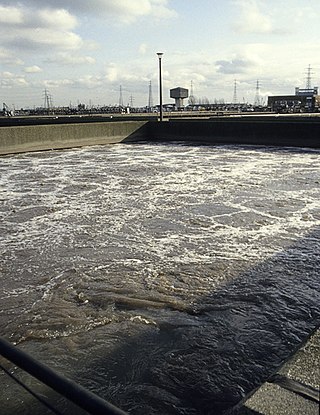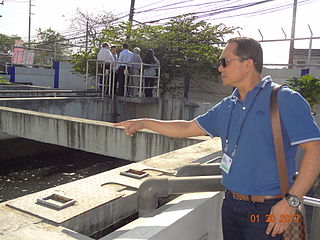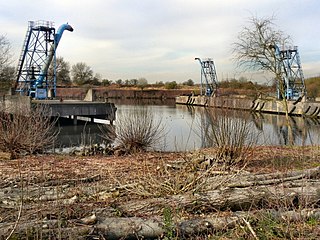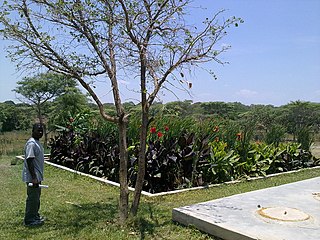
A septic tank is an underground chamber made of concrete, fiberglass, or plastic through which domestic wastewater (sewage) flows for basic sewage treatment. Settling and anaerobic digestion processes reduce solids and organics, but the treatment efficiency is only moderate. Septic tank systems are a type of simple onsite sewage facility. They can be used in areas that are not connected to a sewerage system, such as rural areas. The treated liquid effluent is commonly disposed in a septic drain field, which provides further treatment. Nonetheless, groundwater pollution may occur and can be a problem.

The River Dearne South Yorkshire, England flows roughly east for more than 30 kilometres (19 mi), from its source just inside West Yorkshire. It flows through Denby Dale, Clayton West, Darton, Barnsley, Darfield, Wath upon Dearne, Bolton on Dearne, Adwick upon Dearne and Mexborough to its confluence with the River Don at Denaby Main. Its main tributary is the River Dove, which joins it at Darfield. The river was one of those affected by the 2007 United Kingdom floods.

The River Rother, a waterway in the northern midlands of England, gives its name to the town of Rotherham and to the Rother Valley parliamentary constituency. It rises in Pilsley in Derbyshire and flows in a generally northwards direction through the centre of Chesterfield, where it feeds the Chesterfield Canal, and on through the Rother Valley Country Park and several districts of Sheffield before joining the River Don at Rotherham in Yorkshire. Historically, it powered mills, mainly corn or flour mills, but most had ceased to operate by the early 20th century, and few of the mill buildings survive.

Wastewater treatment is a process which removes and eliminates contaminants from wastewater and converts this into an effluent that can be returned to the water cycle. Once returned to the water cycle, the effluent creates an acceptable impact on the environment or is reused for various purposes. The treatment process takes place in a wastewater treatment plant. There are several kinds of wastewater which are treated at the appropriate type of wastewater treatment plant. For domestic wastewater, the treatment plant is called a Sewage Treatment. For industrial wastewater, treatment either takes place in a separate Industrial wastewater treatment, or in a sewage treatment plant. Further types of wastewater treatment plants include Agricultural wastewater treatment and leachate treatment plants.

The activated sludgeprocess is a type of biological wastewater treatment process for treating sewage or industrial wastewaters using aeration and a biological floc composed of bacteria and protozoa. It uses air and microorganisms to biologically oxidize organic pollutants, producing a waste sludge containing the oxidized material.

The Hyperion Water Reclamation Plant is a sewage treatment plant in southwest Los Angeles, California, next to Dockweiler State Beach on Santa Monica Bay. The plant is the largest sewage treatment facility in the Los Angeles Metropolitan Area and one of the largest plants in the world. Hyperion is operated by the City of Los Angeles, Department of Public Works, and the Bureau of Sanitation. Hyperion is the largest sewage plant by volume west of the Mississippi River.

Secondary treatment is the removal of biodegradable organic matter from sewage or similar kinds of wastewater. The aim is to achieve a certain degree of effluent quality in a sewage treatment plant suitable for the intended disposal or reuse option. A "primary treatment" step often precedes secondary treatment, whereby physical phase separation is used to remove settleable solids. During secondary treatment, biological processes are used to remove dissolved and suspended organic matter measured as biochemical oxygen demand (BOD). These processes are performed by microorganisms in a managed aerobic or anaerobic process depending on the treatment technology. Bacteria and protozoa consume biodegradable soluble organic contaminants while reproducing to form cells of biological solids. Secondary treatment is widely used in sewage treatment and is also applicable to many agricultural and industrial wastewaters.

Sequencing batch reactors (SBR) or sequential batch reactors are a type of activated sludge process for the treatment of wastewater. SBR reactors treat wastewater such as sewage or output from anaerobic digesters or mechanical biological treatment facilities in batches. Oxygen is bubbled through the mixture of wastewater and activated sludge to reduce the organic matter. The treated effluent may be suitable for discharge to surface waters or possibly for use on land.

A trickling filter is a type of wastewater treatment system. It consists of a fixed bed of rocks, coke, gravel, slag, polyurethane foam, sphagnum peat moss, ceramic, or plastic media over which sewage or other wastewater flows downward and causes a layer of microbial slime (biofilm) to grow, covering the bed of media. Aerobic conditions are maintained by splashing, diffusion, and either by forced-air flowing through the bed or natural convection of air if the filter medium is porous. The treatment of sewage or other wastewater with trickling filters is among the oldest and most well characterized treatment technologies.

Sewage treatment is a type of wastewater treatment which aims to remove contaminants from sewage to produce an effluent that is suitable to discharge to the surrounding environment or an intended reuse application, thereby preventing water pollution from raw sewage discharges. Sewage contains wastewater from households and businesses and possibly pre-treated industrial wastewater. There are a high number of sewage treatment processes to choose from. These can range from decentralized systems to large centralized systems involving a network of pipes and pump stations which convey the sewage to a treatment plant. For cities that have a combined sewer, the sewers will also carry urban runoff (stormwater) to the sewage treatment plant. Sewage treatment often involves two main stages, called primary and secondary treatment, while advanced treatment also incorporates a tertiary treatment stage with polishing processes and nutrient removal. Secondary treatment can reduce organic matter from sewage, using aerobic or anaerobic biological processes.

Blackburn Meadows is an area of land just inside the Sheffield city border at Tinsley, England. It became the location of the main sewage treatment works for the city in 1884, and is now one of the largest treatment works in Britain. The treatment process was rudimentary, with sludge being removed to ponds and then to drying beds, after which it was used as manure or transferred by rail to a tip at Kilnhurst. The works progressively expanded to improve the quality of effluent discharged to the River Don and was a pioneer in the use of bio-aeration, following experiments by the works manager during the First World War. This process became known as the "Sheffield System", and was demonstrated to visitors from Great Britain and abroad. Despite these improvements, ammonia levels in the river below the works were high, and fish populations did not survive.


A rotating biological contactor or RBC is a biological fixed-film treatment process used in the secondary treatment of wastewater following primary treatment. The primary treatment process involves removal of grit, sand and coarse suspended material through a screening process, followed by settling of suspended solids. The RBC process allows the wastewater to come in contact with a biological film in order to remove pollutants in the wastewater before discharge of the treated wastewater to the environment, usually a body of water. A rotating biological contactor is a type of secondary (biological) treatment process. It consists of a series of closely spaced, parallel discs mounted on a rotating shaft which is supported just above the surface of the wastewater. Microorganisms grow on the surface of the discs where biological degradation of the wastewater pollutants takes place.
Mixed liquor suspended solids (MLSS) is the concentration of suspended solids, in an aeration tank during the activated sludge process, which occurs during the treatment of waste water. The units MLSS is primarily measured in milligram per litre (mg/L), but for activated sludge its mostly measured in gram per litre [g/L] which is equal to kilogram per cubic metre [kg/m3]. Mixed liquor is a combination of raw or unsettled wastewater or pre-settled wastewater and activated sludge within an aeration tank. MLSS consists mostly of microorganisms and non-biodegradable suspended matter. MLSS is an important part of the activated sludge process to ensure that there is a sufficient quantity of active biomass available to consume the applied quantity of organic pollutant at any time. This is known as the food to microorganism ratio, more commonly notated as the F/M ratio. By maintaining this ratio at the appropriate level the biomass will consume high percentages of the food. This minimizes the loss of residual food in the treated effluent. In simple terms, the more the biomass consumes the lower the biochemical oxygen demand (BOD) will be in the discharge. It is important that MLSS removes COD and BOD in order to purify water for clean surface waters, and subsequently clean drinking water and hygiene. Raw sewage enters in the water treatment process with a concentration of sometimes several hundred mg/L of BOD. Upon being treated by screening, pre-settling, activated sludge processes or other methods of treatment, the concentration of BOD in water can be lowered to less than 2 mg/L, which is considered to be clean, safe to discharge to surface waters or to reuse water.

Mogden Sewage Treatment Works is a sewage treatment plant in the Ivybridge section of Isleworth, West London, formerly known as Mogden. Built in 1931–36 by Middlesex County Council and now operated by Thames Water, it is the third largest sewage works in the United Kingdom. It treats the waste water from about 1.9 million people served by three main sewers serving more than the northwest quarter of Outer London and two further main sewers from the south and south-west. The plant has been extended and is constantly being upgraded with new process, most recently in OfWat Amp6 by the Costain Atkins Joint venture who delivered 6MW of Combined Heat and Power (CHP) generation, New process air blowers for Batteries A & B and six gravity sludge thickening streams. The site covers 55 hectares.

Davyhulme Sewage Works is the main waste water treatment works for the city of Manchester, England, and one of the largest in Europe. It was opened in 1894, and has pioneered the improvement of treatment processes.

A vermifilter is an aerobic treatment system, consisting of a biological reactor containing media that filters organic material from wastewater. The media also provides a habitat for aerobic bacteria and composting earthworms that purify the wastewater by removing pathogens and oxygen demand. The "trickling action" of the wastewater through the media dissolves oxygen into the wastewater, ensuring the treatment environment is aerobic for rapid decomposition of organic substances.

Decentralized wastewater systems convey, treat and dispose or reuse wastewater from small and low-density communities, buildings and dwellings in remote areas, individual public or private properties. Wastewater flow is generated when appropriate water supply is available within the buildings or close to them.



















